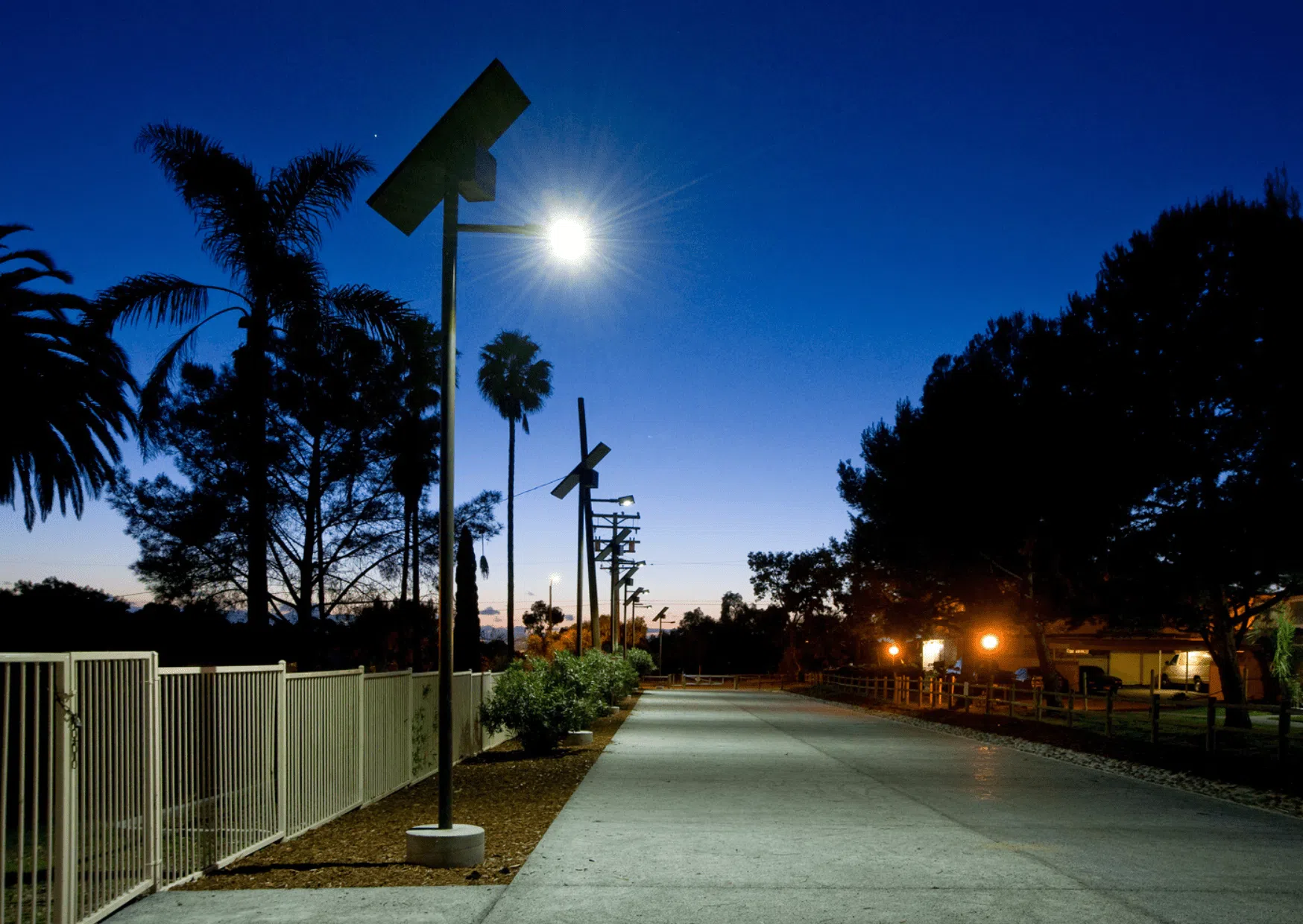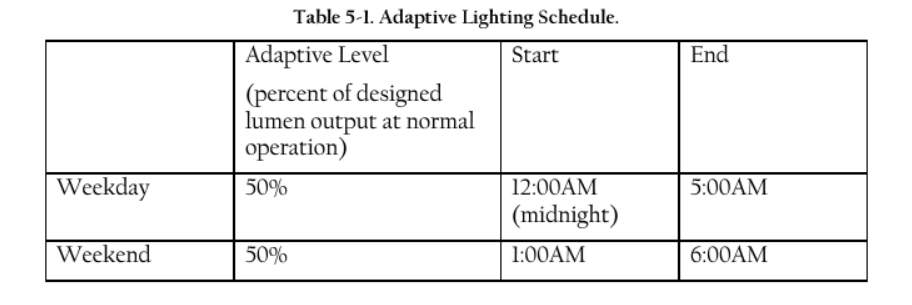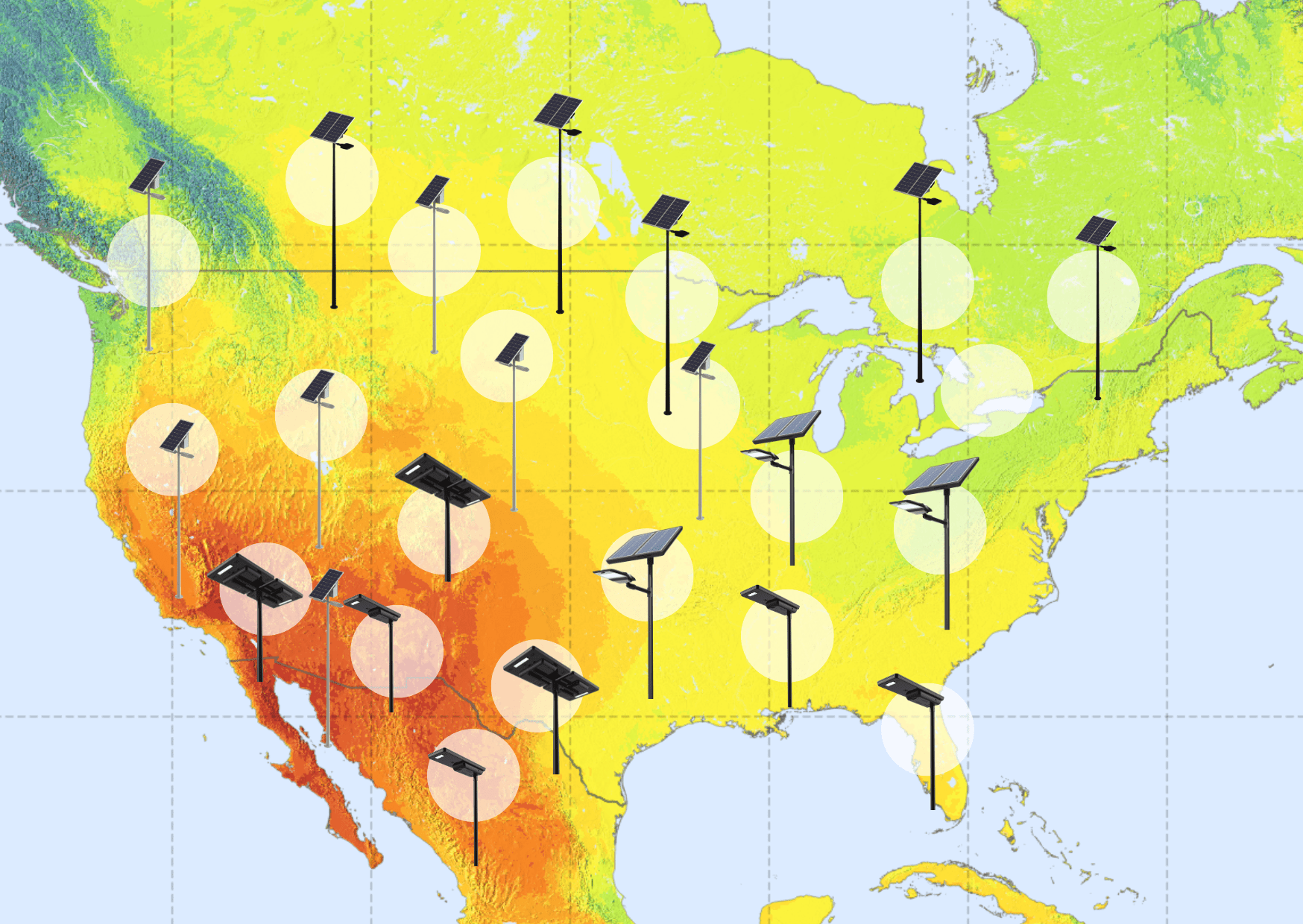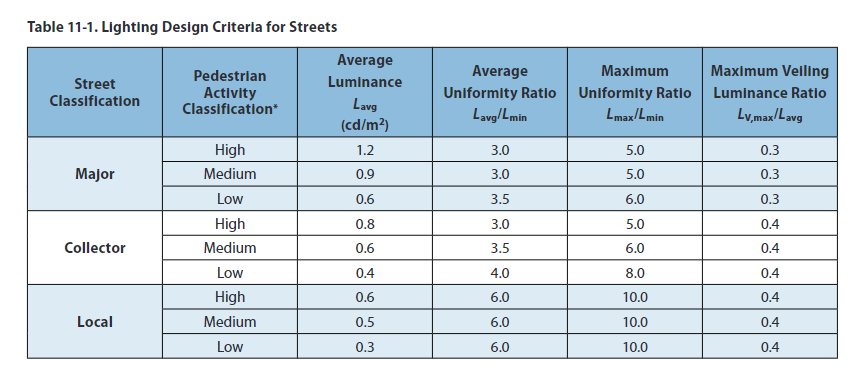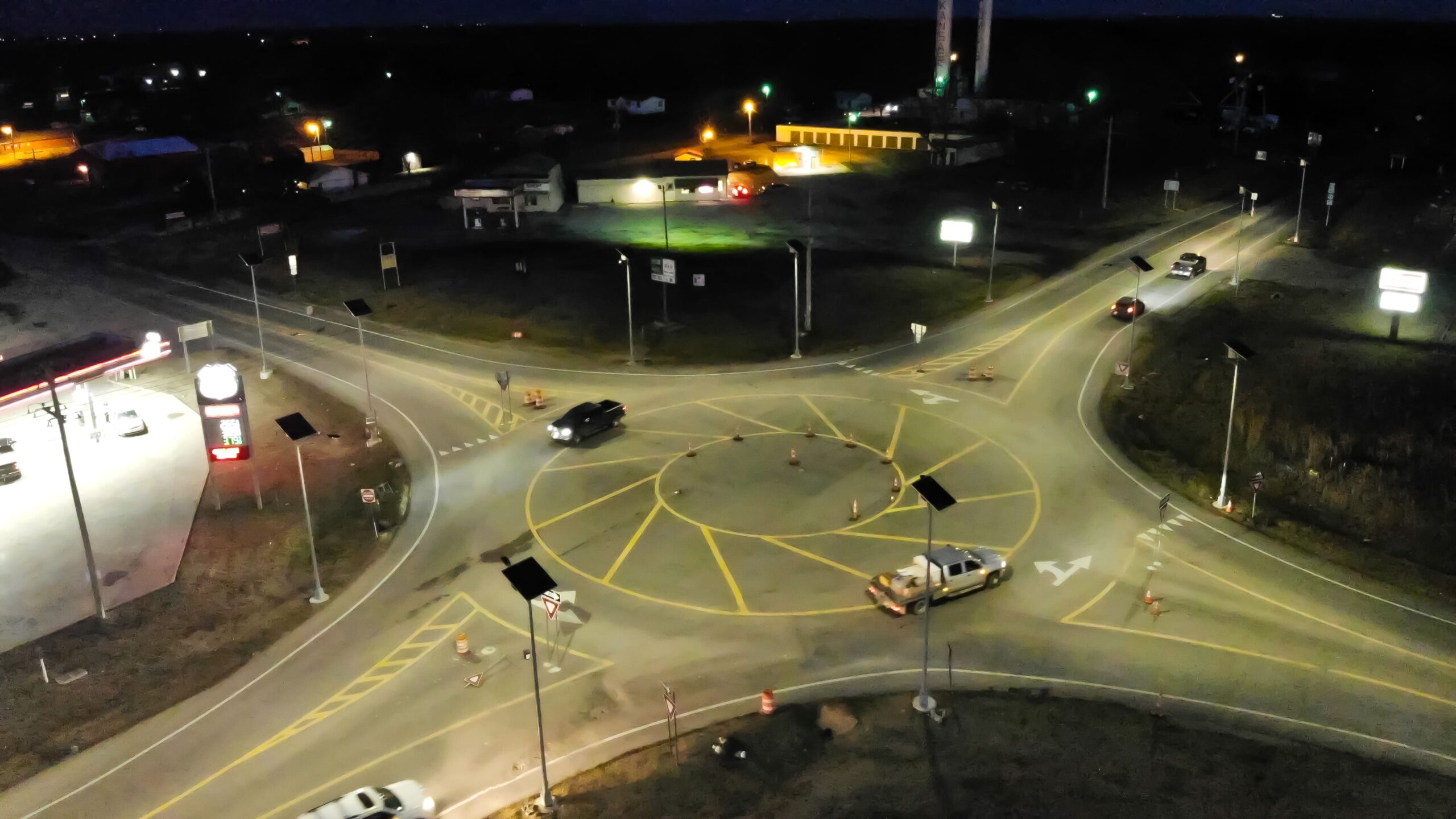The safety advantages of outdoor lighting are widely recognized. On roads, it helps prevent accidents. In neighborhoods, it discourages criminal activities. In parks and other public spaces, it encourages recreational activities and social interactions, creating secure and accessible environments for people to enjoy after dark.  It’s fairly common knowledge by now that lighting an area enhances safety, and hardly anyone—not even us!—would argue against having it available. However, that’s exactly what adaptive lighting proposes: reducing light levels during off-peak hours or, as the FHWA puts it, “using lighting only when necessary and at appropriate levels to ensure safety.† For agencies that associate more light with more safety, this concept can feel unsettling, especially for high-risk areas like roads. Yet, adaptive lighting isn’t novel or extreme. With updated guidelines from the Illuminating Engineering Society (ANSI/IES-RP-8-22), there’s increasing support for implementing it and enjoying its benefits.    Adaptive lighting might best be described by what it isn’t: static. Unlike a timer that turns lights on and off at fixed times each night, or a photocell that adjusts lights based on ambient light, adaptive lighting employs a control system (either centralized or per luminaire) to adjust light levels in response to environmental changes.  These changes can vary widely—from traffic volume to weather conditions to pedestrian activity—all of which influence the required lighting intensity. For instance, on residential streets, pedestrian counts typically follow a predictable pattern, peaking in the early evening before tapering off around 10 or 11 p.m. In commercial zones, activity aligns with business hours. With adaptive lighting, light can be provided when needed and scaled back when unnecessary.   Example lighting schedule from the City of San Jose’s Streetlight Design Guide. The city was one of the first in the nation to recognize the benefits of adaptive lighting and formalize its implementation.    For agencies using conventional AC-powered lighting, the motivation to explore adaptive lighting is clear: reduced energy consumption, decreased strain on the grid, and lower utility bills. But there are reasons why we, a solar lighting manufacturer (whose products are already off-grid and free to operate), are enthusiastic about adaptive lighting too.  To start, while financial savings might not concern us, we remain keenly interested in minimizing energy demands. Why? Lower energy requirements mean we can use fewer and smaller solar panels and batteries, which reduces both system size and cost. (Smaller systems weigh less, making cheaper poles feasible; batteries and panels add weight and expense, so the smaller, the better!)  Reducing system load also allows us to expand the reach of solar lighting into regions that previously couldn’t sustain a constant output. A solar streetlight in a place like Kalispell, Montana, might struggle to generate enough energy to provide 12,000 lumens throughout the night in winter. Dimming the light to, say, 50% from midnight to 5 a.m., could make it viable. (Don’t worry—we always do the math to ensure proper sizing.)   Reducing system load using adaptive lighting extends the reach of solar lighting to high-latitude locations that receive less solar radiation.  Finally, we’d be remiss not to highlight the environmental benefits of adaptive lighting. Cutting a fixture’s output, even briefly, can significantly reduce light pollution, which has been shown to mimic, mask, or confuse natural light signals for both wildlife and humans. Adaptive lighting minimizes the negative impact of light on ecosystems, ensuring illumination that is low-level, controlled, and purposeful—three principles emphasized by the IES.    Having convinced you of adaptive lighting’s merits, let’s turn to RP-8-22, which offers the latest recommendations for implementing it in the U.S. (Our international readers may note that similar guidelines exist in Canada and the UK.)  RP-8-22 uses two factors to determine required lighting levels: the street classification and the level of pedestrian activity. Classification depends on lane count and traffic volume and is determined by the city (many cities map their roads accordingly). Pedestrian activity levels are estimates of the number of pedestrians on a given sidewalk block during peak nighttime hours (some cities provide this data, though obtaining accurate pedestrian information remains challenging).   In the table above, pedestrian activity classifications are as follows: volumes greater than 100 are high, between 10 and 100 are medium, and below 10 are low.  For adaptive lighting, we focus on times when pedestrian volumes shift between levels. For example, if pedestrian volumes on a local road fell from 120 per hour at 6 p.m. to 30 at 10 p.m., the average luminance could be adjusted according to RP-8’s recommendations. When pedestrian presence rises in the morning, light levels could increase before eventually switching off post-sunrise.  An increasing number of municipalities and utilities are adopting these updated RP-8 recommendations in new solar lighting projects, addressing previous liability concerns. (Cities, counties, and utilities have faced lawsuits for failing to provide adequate lighting, though they are rarely held liable in such cases.)   While RP-8 suggests considering reduced light levels based on pedestrian activity for local, collector, and arterial roads, as well as sidewalks and alleys, it warns against a one-size-fits-all approach. It shouldn’t be applied in the following scenarios:   Figure 4: Adaptive lighting is not recommended for certain roadway applications, including roundabouts. For locations requiring continuous operation, Sol’s EverGen lights offer a dependable, durable solar-powered solution.  Even if a location qualifies for adaptive lighting, it’s essential to take a thoughtful approach that accounts for local conditions and user needs. Obtaining accurate pedestrian data can be tricky, and activity patterns are often complex (for example, streets near stadiums may be crowded on game nights but empty on other days, making broad adjustments risky). As RP-8 notes, “It is the responsibility of the lighting designer to apply sound reasoning and logic in determining pedestrian activity and schedules.†   For situations where complete scheduling changes aren’t feasible due to unpredictable or unclear pedestrian usage, or where the consequences of insufficient lighting are severe, there’s an alternative: motion detection. Sensors come in various forms—radar, infrared, hybrid—and can alter the light state when motion is detected (e.g., turning lights on or increasing brightness).  Motion detection proves useful in numerous settings, including parking lots, industrial areas, parks, and campus pathways. According to RP-8, “Police often prefer motion-sensitive lights in alleys so that activity can be noticed by neighbors or from nearby streets, as the lights’ activation signals something is happening.† Wherever used, motion detectors deliver many of the same benefits as adaptive lighting, offering energy savings without compromising safety. And if full output is required (such as at roundabouts or multi-use paths with high nighttime use), know that Sol’s systems are up to the task, providing reliable dusk-to-dawn illumination wherever needed.    Historically, agencies hesitated to reduce lighting for fear of diminishing safety. Current IES guidelines now allow and even promote adaptability. Several cities, including San Jose, have embraced adaptive lighting guidelines, and federal grant programs like Safe Streets and Roads for All specifically list it as eligible.  This shift toward adaptive lighting excites us in the solar industry because it enables us to deliver compact, cost-effective systems to an even broader range of locations and customers—something we’re eager to achieve! If you’re curious about adaptive lighting or think your project could benefit from it, don’t hesitate to reach out.  Barium Stearate,Stearic Acid Barium Stabilizers,Barium Stearate Stabilizer,Heat Stabilizer Barium Stearate Jiangsu Greya New Material Technology Co., Ltd. , https://www.greyastabilizer.comWhat is adaptive lighting?
Why adapt?
Where and how to implement adaptive lighting
Where not to use adaptive lighting
Alternatives to adaptive lighting
Ready to make the switch?
What RP-8-22 says about adaptive lighting—and what it means for solar
```html
```
Contact Us
